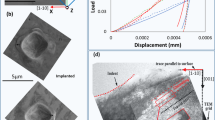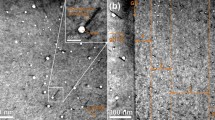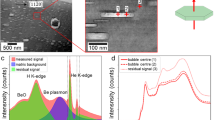Abstract
ION irradiation of metals with helium or hydrogen isotopes commonly results in the formation of microscopic gas bubbles. At very high doses, radiation blistering and related phenomena can cause severe damage to surfaces1. Much research has been stimulated by the need to find materials with acceptable erosion and gas loading properties for use in future controlled thermonuclear reactors. Bubble formation is also important in fission-reactor fuel technology and other applications2,3. The underlying bubble structure of face-centred-cubic (f.c.c.) metals has remained largely unknown, although much has been done on depth profiling light gases implanted to high doses (see, for example, refs 3–5). Inert-gas bubbles lying on a space lattice have been reported previously only for the body-centred-cubic (b.c.c.) metal molybdenum6,7. There have been many observations, mainly for b.c.c. metals, of the similar ordering of voids produced by particle irradiation8,9. The void lattice spacing is typically 5–10 times that found for bubbles (∼5 nm). We report here on the bubbles produced in several f.c.c. metals by 30 keV helium-ion irradiation to a level just below the critical dose for blistering. A new result for this important class of metals is that the helium gas bubbles lie on a superlattice having an f.c.c. structure with principal axes aligned with those of the matrix.
This is a preview of subscription content, access via your institution
Access options
Subscribe to this journal
Receive 51 print issues and online access
$199.00 per year
only $3.90 per issue
Buy this article
- Purchase on Springer Link
- Instant access to full article PDF
Prices may be subject to local taxes which are calculated during checkout
Similar content being viewed by others
References
Das, S. K. & Kaminsky, M. in Proc. Symp. on Radiation Effects on Solid Surfaces, Chicago (Advances in Chemistry Series, 1975).
Whitmell, D. S., Williamson, R. & Nelson, R. S. Proc. IPAT '77, 202–206 (CEP Consultants, Edinburgh, 1977).
Johnson, P. B. & Armstrong, T. R. Appl. phys. Lett. 31, 325–327 (1977); Nucl. Instr. Meth. 148, 85–92 (1978).
Terreault, B. et al. Can. J. Phys. 56, No. 2, 235–247 (1978).
Alstetter, C. J., Behrisch, R., Bøttiger, J., Pohl, F. & Scherzer, B. M. U. Nucl. Instr. Meth. 149, 59–63 (1978).
Sass, S. L. & Eyre, B. L. Phil. Mag. 27, 1447–1453 (1973).
Mazey, D. J., Eyre, B. L., Evans, J. H., Erents, S. K. & McCracken, G. M. J. Nucl. Mater. 64, 145–156 (1977).
Evans, J. H. Nature 229, 403–404 (1971); Rad. Effects 10, 55–60 (1971).
Chadderton, L. T., Johnson, E. & Wohlenberg, T. Comments Solid State Physics 7, 5, 105–115 (1976).
Matthews, M. D. Harwell Report AERE R-7805 1–40 (1975).
Evans, J. H. J. nucl. Mater. 68, 129–140 (1977).
Author information
Authors and Affiliations
Rights and permissions
About this article
Cite this article
JOHNSON, P., MAZEY, D. Helium gas bubble lattices in face-centred-cubic metals. Nature 276, 595–596 (1978). https://doi.org/10.1038/276595a0
Received:
Accepted:
Issue Date:
DOI: https://doi.org/10.1038/276595a0
This article is cited by
-
Ordering the void
Nature Materials (2020)
-
Irradiation-Dependent Helium Gas Bubble Superlattice in Tungsten
Scientific Reports (2019)
-
Engineering self-organising helium bubble lattices in tungsten
Scientific Reports (2017)
-
Interface-Induced Ordering of Gas Molecules Confined in a Small Space
Scientific Reports (2014)
-
Analysis of elastic interactions between holes
Journal of Materials Science (1992)
Comments
By submitting a comment you agree to abide by our Terms and Community Guidelines. If you find something abusive or that does not comply with our terms or guidelines please flag it as inappropriate.



